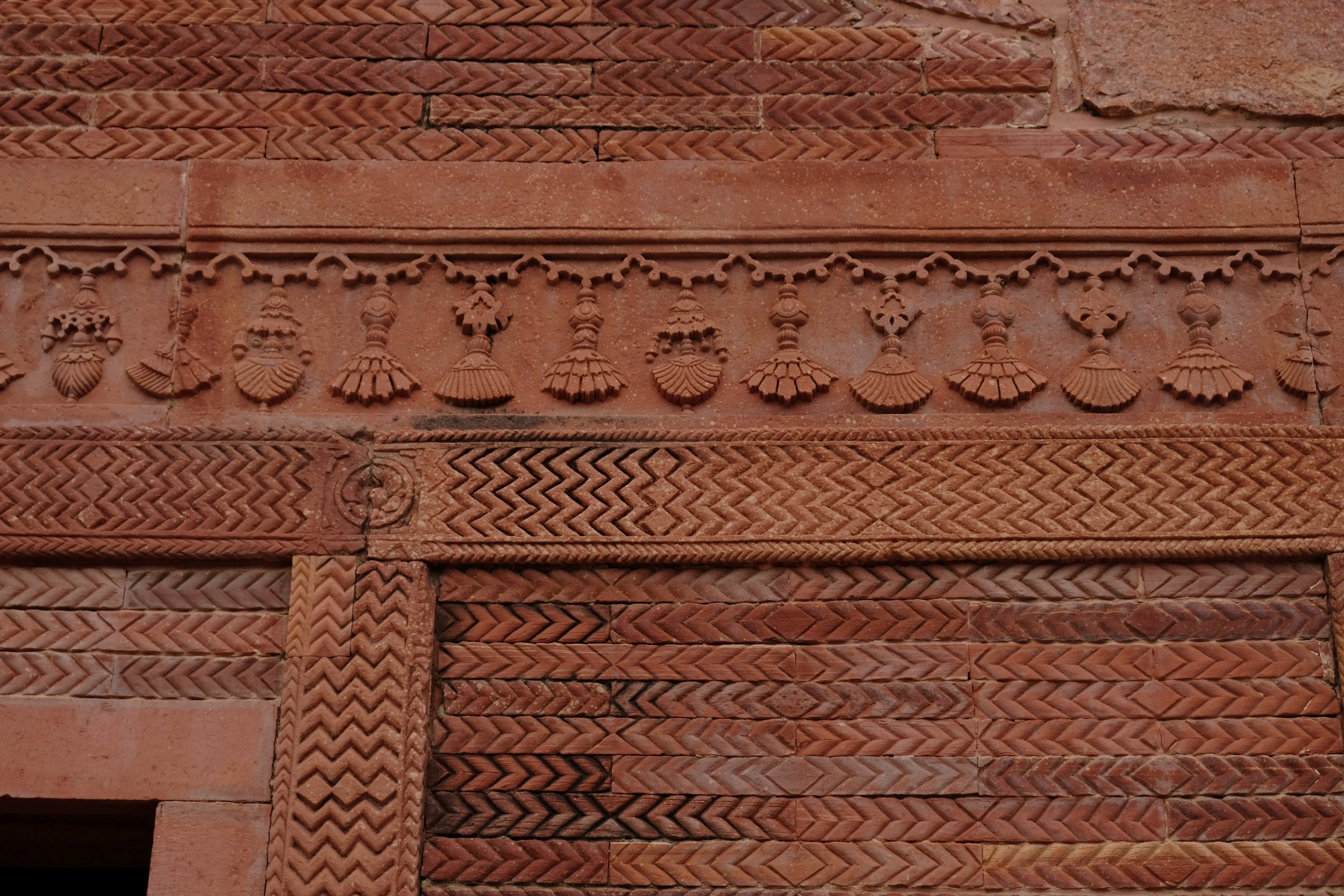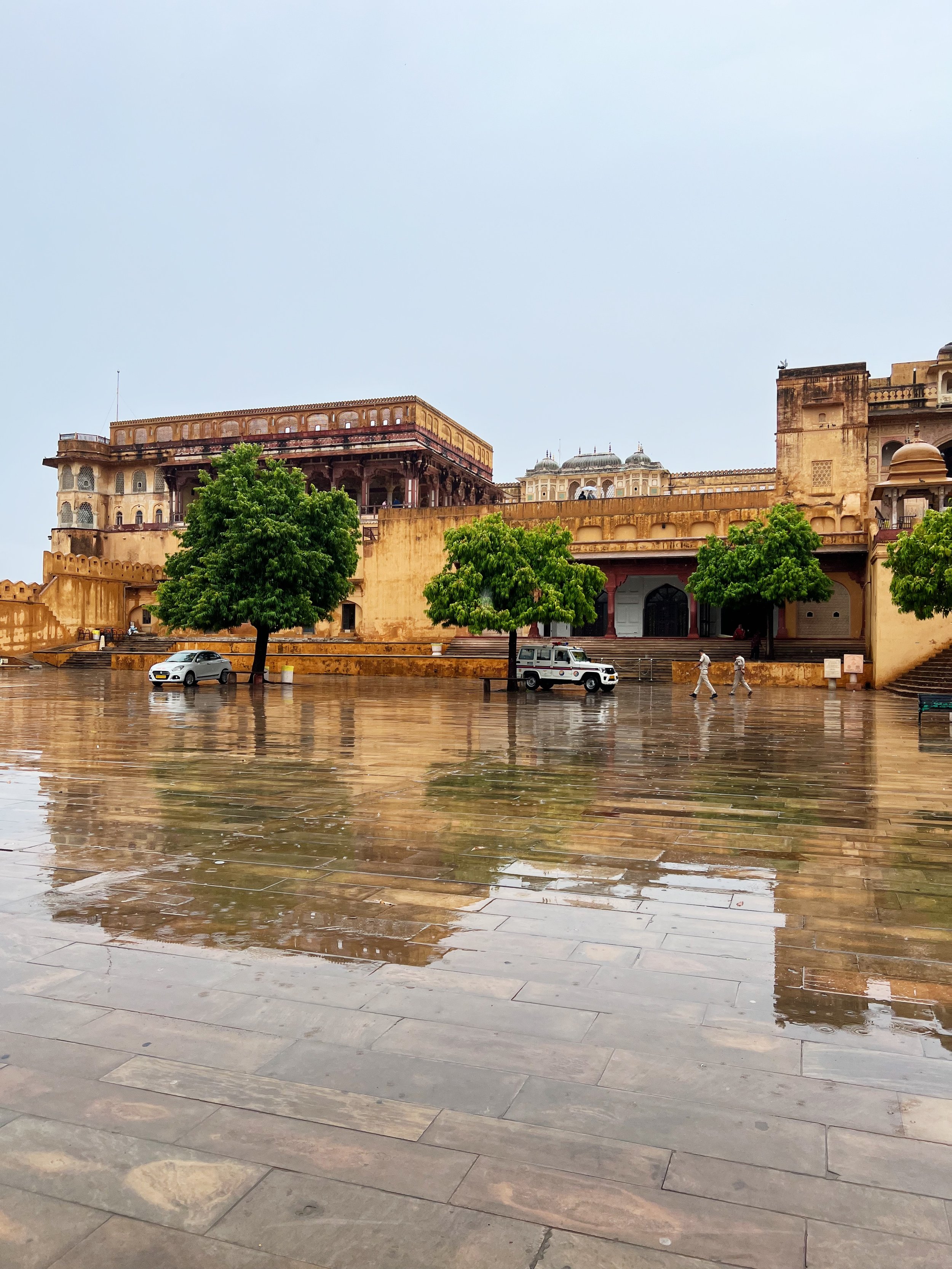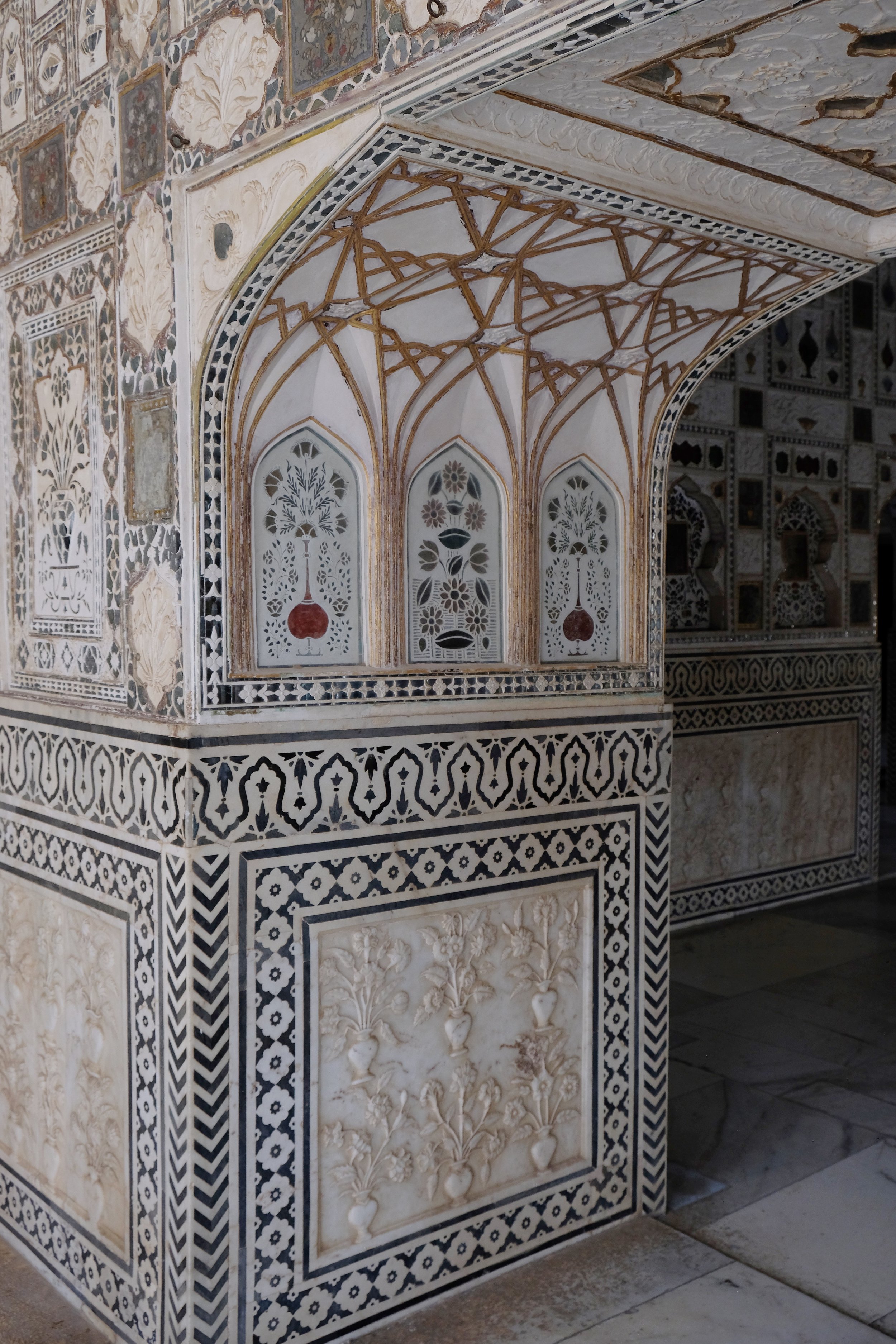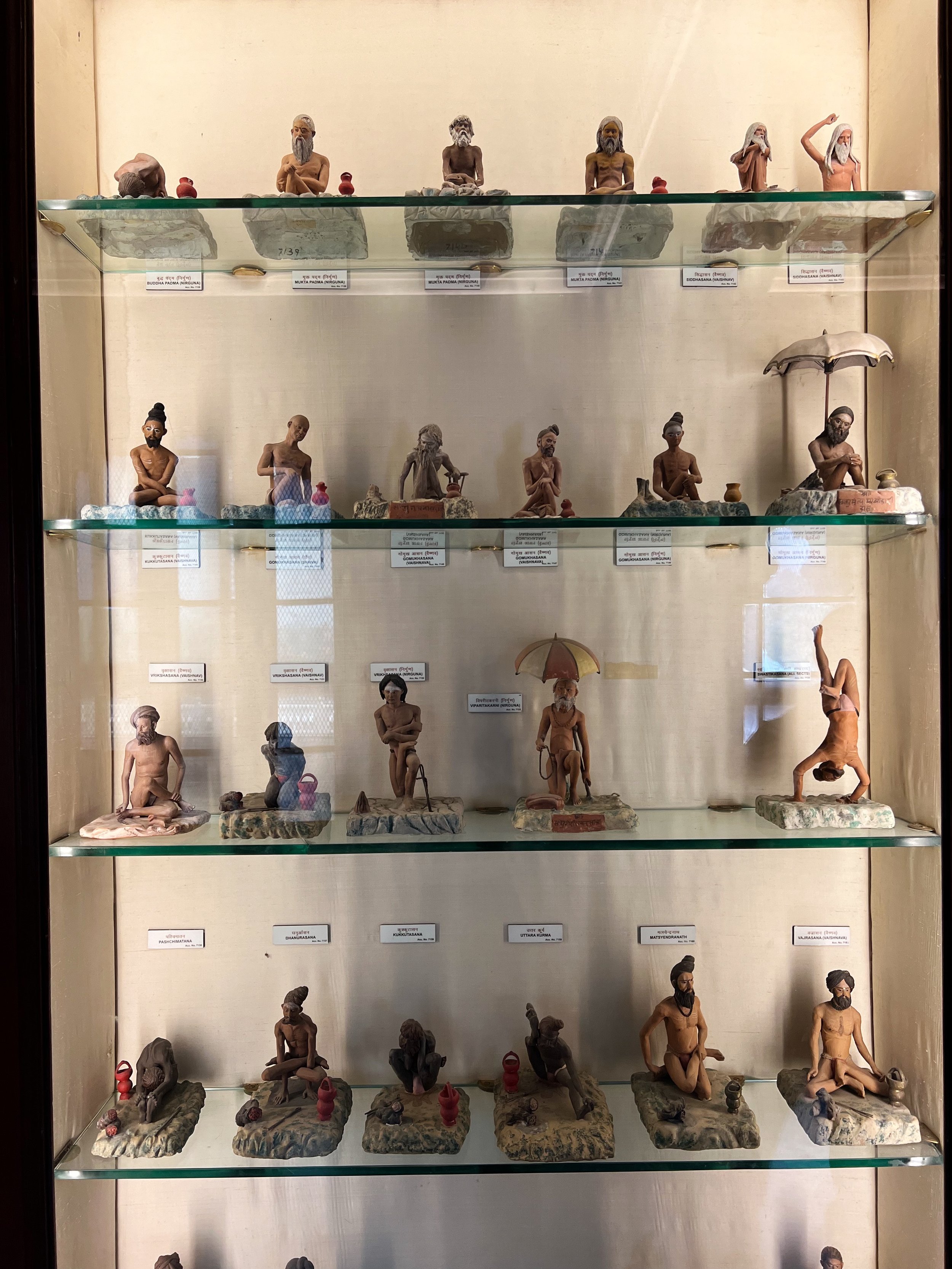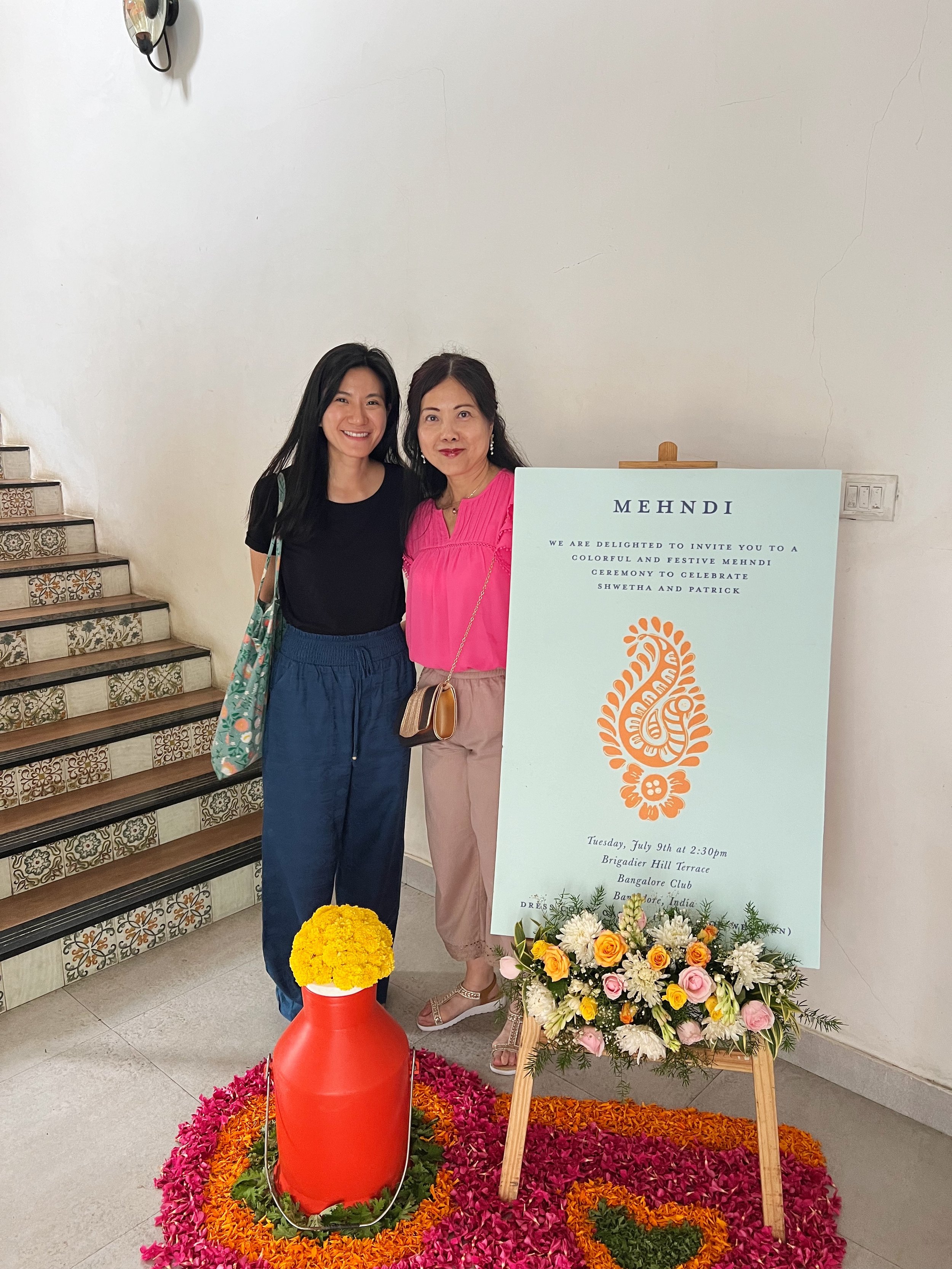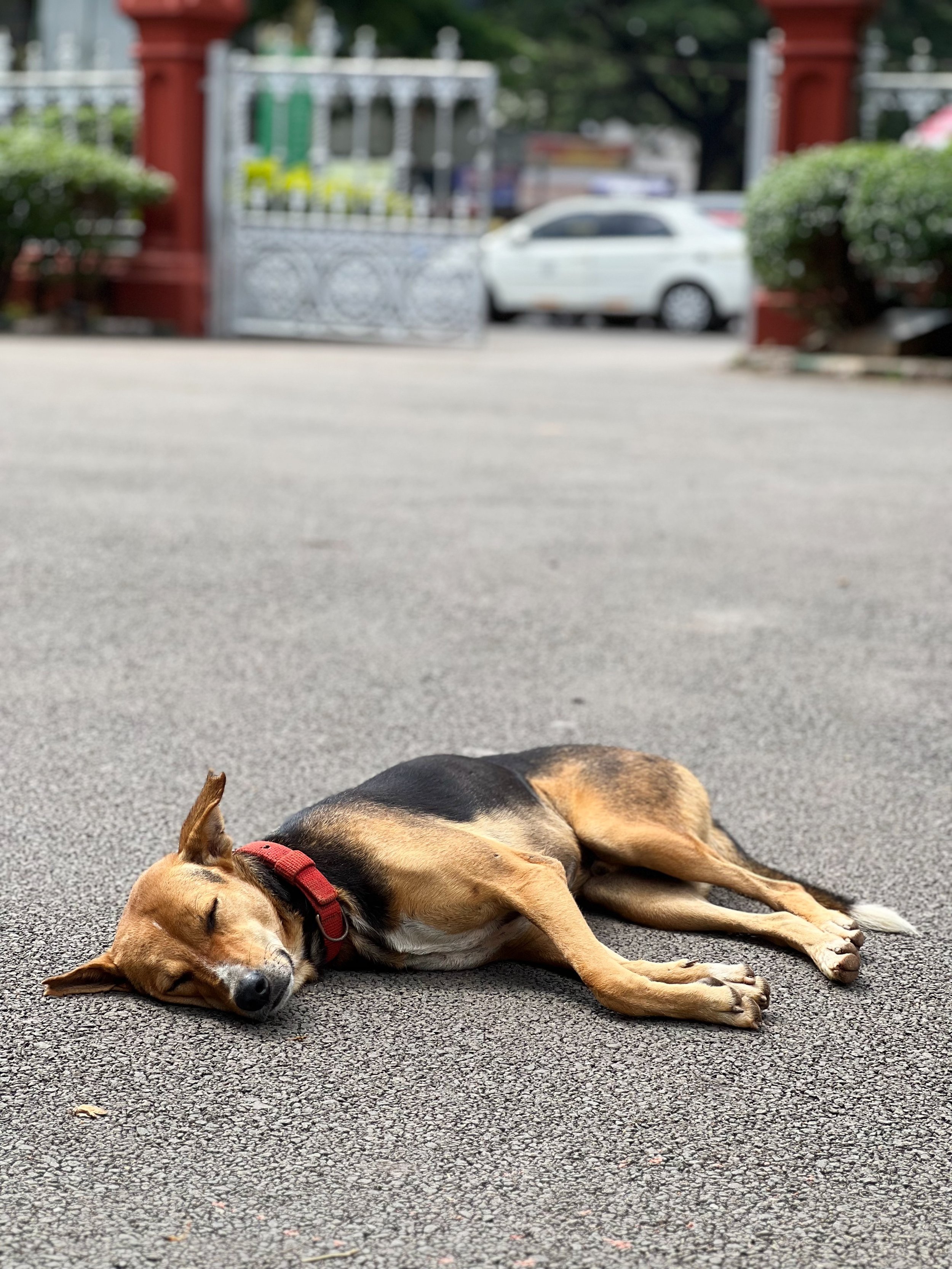India Part 2. June 2024
Postcard from India
Agra Fort
We continued our sweaty journey to Agra Fort, the original red fort build with red sandstones. This is one of the finest Mughal forts in India, and it’s construction started in 1565, primarily built as a military structure and later transformed into a palace, and then later a prison for Shah Jahan after his son seized power in 1658. At one point there were 500 castles inside the fort but 95% of them were destroyed by the British. A defense system is built into the entrance of the fort, with a water section with crocodiles, a set of 3 gates not all visible to each other, and a ramp that’s at 45 degrees to allow rocks and stones to roll down at your enemies.
We started off the tour with the huge red sandstone Jahangir Palace, blending in Indian and Central Asian architecture. Right outside is Hauz-i-Jahangir, a huge bowl carved out of a single block of stone, used for bathing. It was actually initially plated with gold and placed inside the palace. When the British took over they wanted to move it but half way through moving they realized it was too heavy to be gold and left it where it is today.
Within the palace you can see the intricate designs on the columns, where the king used to sleep.
From there we toured the summer and winter palaces, designed to use water to cool and heat the space. The summer palace has hollow walls to allow water to flow through; the winter palace has water on the bottom that can be heated. A water tank and pipe set up is in the center in between the two palaces, and the water tanks also powers all the fountains within the fort (how smart).
Khas Mahal is the wonderful white marble octagonal tower and palace where Shah Jahan spent the rest of his life in house arrest. The view looks out to the Taj Mahal and it was said that he used a mirror to look at the reflection of the Taj due to his old age. He had a private mosque Meena Masjid and that was the only place he was allowed to go outside of Khas Mahal. Just before wrapping up our tour, we also saw the Nagina Masjid (Gem Mosque) built for the ladies of the court, down below the Ladies Bazaar, Diwan-i-Kahs (hall of private audiences) and the Diwan-i-Am (hall of public audiences).
Itimad-ud-Daulah (Baby Taj)
Last sight of the day is across the river at Itimad-Ud-Daulah, better known as Baby Taj Mahal. It’s an exquisite tomb built before the Taj, by Nur Jahan for his father. The delicate appearance is shown as soon as you enter with the inlay work and the paintings kept in its original condition. The lighting was also perfect as it’s golden hour, and I captured so many photos of the archway and the four gates - put in place for symmetry rather than for practical reasons since there is actually only one single functional gate for entrance and exit. The ceiling is also not to be missed as there is still some gold on the walls within the paintings!
Dinner and Hotel in Agra
We grabbed dinner at Pinch of Spice right across from our hotel and after dinner our driver took us to our hotel, ITC Mughal. It was amazing to finally rest up at this lovely hotel. The next morning we got our continental breakfast spread and I did a walkthrough of the hotel - they actually have 2 pools and even a badminton net set up! Too bad we’re only staying 1 night and didn’t get to enjoy all the facilities.
Fatehpur Sikri
On the fourth day of our tour, we departed from Agra and headed to Fatehpur Sikri, a fortified ancient city 40km west of Agra and on the way to Jaipur. We drove through the busy streets of Agra just before leaving town and onto the highway, and I felt a sharp contrast of me inside an air-conditioned car and the outside world. The wealth disparity in this country is definitely still very strong.
We met our local guide Kumar in Fatehpur Sikri, and we took a golf cart to the north-east entrance. Fetehpur Sikri was the short lived capital of the Mughal empire in the 1500’s, during the third Mughal king. He visited the village to consult the Sufi saint Salim Chisti, who predicted he would get an heir to his throne. When the prophecy came true, the king built his capital here, consisting of a mosque that is still in use and three palaces, one for each of his wives (one Hindu, one Muslim and one Christian). This Mughal king is also the grandfather of Shah Jahan, the king who built Taj Mahal.
We started our tour at the Hall of Public Audience, now a courtyard. Then we entered into another courtyard, Pachisi Courtyard, with the Jewel House to the right, which has a modified center stone that has all 3 religions - Hindu, Muslim and Christianity, all incorporated. The building is actually 2 storied with doors and narrow staircases but access is not allowed.
In the courtyard there is a game board on the gorund for pachisi where the king used slave girls in colorful dresses as pieces. Behind there is a 5-storied palace, Panch Mahal, built using on columns. The lowest level has 84 different columns and it decreases in size as you go up.
In the southeast corner is the most intricately carved structure in the whole complex, Rumi Sultana, said to be the palace built for Akbar’s Turkish Muslim wife. Even the ceiling and columns and walls were all carved with plants and animals and intricate patterns. There is an Ornamental Pool where singers and dancers would perform on the platform above the water, and another private pavilion for the king behind it.
Next up is Palace of Jodha Bai, the king’s favorite wife as she gave him an heir. There were two different kitchens, one for vegetarian and one non vegetarian for his wives, and you can see the designs on the walls with floral and geometric patterns and bands of jhumkas (ear-ornaments). In the center was the Palace of the Christian (Goan) wife.
Outside we walked over to the mosque and we entered through King’s Gate. Inside there is a white marbled Tomb of Shaikh Salim Chisti. Our guide led us to a priest who walked us through the offering process which we did inside the tomb. First layering down a piece of cloth, then rose pedals, and finally a string to tie to the 56 carved marble design wall. One knot represents one wish and there can be a maximum of three. We exited the complex through the Victory Gate, the tallest gate in all of Asia where you can see the steep stairs below and the view of the city. Hawkers and children are there to stop you, and this is probably the worst I have seen on the trip thus far.
Onwards to Jaipur
We hopped back onto our car as the rain start rolling in, stopping at a tourist trap for lunch. Food wasn’t bad but definitely catered to tourists taking this golden triangle journey from Agra to Jaipur. It was raining for majority of the ride but we caught herds of sheep sharing the highway with us. Our Jaipur guide RV also called to confirm our starting time tomorrow. We arrived at the beautiful ITC Rajputana Hotel around 4:30PM, and decided to stay in to try the hotel restaurant, Peshawri. We got the dal bukhara, onion kulcha (pita bread), and tandoori pomfret which is a whole fish with yellow chili, garam masala and turmeric roasted in the clay oven. The food was delicious but definitely on the pricier side. At the end of the meal we got this packaged mouth freshener that that absolutely not for my taste. It was some herbs that you have to chew on and I gave it a try and spat it back out. I’ll just stick to gum…
Hama Mahal
The next morning our wake up call was early at 6:45AM but I still woke up pretty energized. I kept my plans and wore my newly purchased white dress despite the cloudy and rainy forecast. We finished breakfast at the hotel and our guide RV was already waiting for us at the lobby by 8:30AM. On our way to our first stop RV explained a little but of history for Jaipur. Jaipur is made up of Old City (Pink City), New City (where our hotel is located), and the city has a total of nine gates, one for each planet. Our first quick stop is probably Jaipur’s most distinct landmark, the Hama Mahal. It’s a pink-painted, honey-combed hive that’s five-storied high. It was built in 1799 to enable ladies of the royal household to watch life and processions of the city. It looks like a very narrow structure (and is) but there is nothing much to see inside so much people just take photos from the opposite side of the street.
Panna Meena Ka Kund
On our way to the Amber Fort, our guide RV said he had a surprise for us. After stopping for a quick photo at the foot of the hill looking up to Amber Fort, the car continue up the steep road and stopped, and we actually arrived at Panna Meena Ka Kund, where queens used to bathe. It was a nice surprise to kick off our tour since I read about the zigzagging steps of the step well in the guide book, but it wasn’t on our tour itinerary.
Amber Fort
Jaipur was the former capital of the Jaipur state and a very well designed city, but before Jaipur there was Amber. From the viewpoint you can actually see the three forts surrounding Jaipur - Amber Fort, Nahargarh Fort (Tiger Fort for defense), and Jaigarh Fort, the one built at an even higher elevation than Amber Fort. The construction of Amber Fort began in 1592, and we started off the tour at the Sun and Moon Gates. There is an option to ascend the fort on elephants (they only work for two hours a day), but we took the car instead.
Through the Sun Gate (Suraj Pol), we were lead to the main courtyard, where the victory parades would be (and also where the elephants would enter). Women would view from the veiled windows of the palace. Across the Sun Gate is the Moon Gate (Chand Pol).
Up the stairs we visited the small marble temple (Shila Devi Temple), and we were blessed with bindi and a flower wreath. We continued onto the Diwan-i-Am (Hall of Public Audiences), with the main platform raised for the king. On the far left side is a section for the government officials with beautiful columns that make up cubicles, and it looks out onto the intricately designed Saffron Garden floating in the middle of the water. Within the hall there’s even a whole Turkish bath system set up - very well designed for its age!
Through the beautiful Ganesh Gate, named after the Hindu deity Ganesha, we entered a hallway decorated with hand painted flowers, and into Jai Mandir, the Mirror Palace with the most beautiful ceiling. The ceiling and walls are made up many pieces of glittering glass. It is said that the king and the queen would light up hundreds of candles and they would reflect over the mirrors, creating an illusion of glittering stars.
This space alone is probably the most crowded in all of Amber Fort, but I had a lot of fun taking photos.
After the Mirror Palace we continued to the Palace of Raja Man Singh, going up the ramp to the 2nd floor, with sections off into different spaces for each one of his wives. You can really admire how grand this space is and the designs that remained on the walls of the palace. The skies cleared up a bit as we were leaving the Amber Fort and you could see a bit of the Amber town down below from the fort.
Jal Mahal
We took a quick photo stop at Jal Mahal, the water palace built in the middle of a manmade lake/ dam. It was believed to be a summer palace, and a restoration project actually began in 2003 but it never got completely approved so it remains closed to the public.
City Palace
The rain continued as the day went on and we headed to City Palace, with a very ornate front gate. Part of the gallery is closed for renovations but we did get to see the Maharaja Sawai Mansingh II Museum which as a collection of costumes and Kashmiri pashmina. It also has Sawai Madho Singh I’s large clothing on display - he was said to be 7ft tall and weighed 250kg. In the middle was the Hall of Private Audience, a pink and white, marble-paved gallery. There are two large containers called Gangajali on display, said to hold the holy water from the Indian sacred river Ganga for one of the kings when he traveled to the England to attend the coronation of King Edward VII in 1902.
One of the remarkable sights in the Palace was the inner courtyard with the four seasons gates, Pritam Niwas Chowk. The Peacock Gate for autumn, Lotus Gate for summer, Green Gate for spring and Rose Gate for winter. Behind the chowk is the private palace, Chandra Mahal where the royal family still lives. The current king is only 24 years old (sadly he is not single). There is an optional royal tour for 5000INR that would allow you access to the private palace but reviews online have said it’s not really worth it. We instead went to the Museum of Friends where the local craftsmen show you their intricate work - I ended up purchasing a painting done with squirrel hair, a magnet, a wooden, handcrafted Ganesha figure, and magnets made with copper and gold. All of these craftsmen are subsidized by the government and they all met King Charles when he visited Jaipur in the early 2000s. Just before lunch we also stopped by a shop run by Princess Diya Kumari and her foundation PDKF. They train women in traditional crafts and I got some keychains as souvenirs. Lunch was within the palace at Baradari, a really nice restaurant (their pastas were really good with some Indian spices - I’ve discovered a new favorite).
Pandit Kulfi and Drinks
After the City Palace we were actually done with the day’s scheduled programming, as the Jantar Mantar is an observatory but without the sun there would be no sundial to see and it would just be some large structures for us to see. We decided to head to Pandit Kulfi, one of the oldest vendor in Jaipur selling kulfi, to try their mixed kulfi (and saw some monkeys while having our treat), to a boutique for mom to do some shopping and staying in at the hotel. We went to the hotel bar to try some Indian red wine and chicken spring rolls to call it a night.
Bapu Bazaar
It’s the last day of our tour and it’s another hot, humid and rainy day in Jaipur. We slept in a bit and after breakfast and checking out of the hotel we headed to Bapu Bazaar (named after jewels) to do some local shopping. The shops started opening around 11AM and you can find textiles, jewelry and souvenirs in rows and rows of stalls. We leveraged our bargaining skills and got a few deals, and came back full of purchases.
Albert Hall Museum
After finishing shopping (efficiently) at noon, we asked Sanjeev to take us to the Albert Hall Museum, the oldest museum in Rajasthan, India. It’s named after King Edward VII (Albert Edward), as he visited the city as the Prince of Wales and the city was painted pink for his visit. There were actually lots to see inside the museum, and a lot of works that we saw throughout our trip, including the detailed painted work, lacquer work, marble, block printing, carpet weaving etc. The gold and gemstones were also cool.
Lunch at Spice Court
This lunch spot on the new city side of Jaipur was recommended by our guide RV yesterday. It started pouring, and I mean POURING when we were heading over for lunch and we unfortunately got caught in the rain as we were heading into the restaurant. We tried the Rajasthani Laal Maas and it was pretty good! I swear I thought my spice tolerance would go up after spending a month in India but I guess not… Spicy food is still… spicy to me…
Patrika Gate
On our way to the airport to catch our flight back to Bangalore, we stopped at Patrika Gate, a spot built in 2016 by the newspaper Patrika Group. It does have Rajasthan art and is made popular by social media, but we had to literally leap through puddles of water to get to the gate that is in the middle of a traffic circle. After the earlier rain, we had to find a way into the walkway from where you get off a car. I did get some photos but I think it’s only worth it on a nicer weather day, maybe for a pre-wedding shoot. There were also plenty of photographers asking if you wanted your photographs taken, so that ruined the experience a bit for me.
From Patrika Gate it was only a 10 min ride to the airport. We said goodbye to our driver Sanjeev as he would be driving back to Delhi, and we hopped on our evening flight back to Bangalore, concluding our 5 day tour of Delhi, Agra and Jaipur.
Indian Wedding in full Gear
The wedding is taking place over 4 days and back in Bangalore we went back into wedding preparation mode. The first day after our trip was a rest day for us to complete any last minute preparation, picking up our lehengas and mom’s sari blouse. Day one of the wedding is the Vara Puja, the Hindu wedding celebration of the public introduction and announcement of the bridegroom to society, and welcoming the groom at my Auntie’s home. Mom and I did each other’s hair and would continue doing that for the rest of the wedding days.
The night of day one is also the Sangeet at the Bangalore Club. There were dancing and performances, a whole celebration. And of course there’s an afterparty at the hotel suite.
Cubbon Park and Vidhana Soudha
Day 2 wedding festivities actually start in the evening so we took the morning to explore Bangalore a bit on our own. Mom and I crossed through multiple crosswalks (there are no pedestrian lights of course) over to Cubbon Park which was right across from the JW Marriott Hotel, and eventually to Vidhana Soudha, the state government building built in 1954. The park was actually very nice and spacious, though not blocked off by traffic. But to get to Vidhana Soudha on the other side of the park, we were told by Google Maps to cut through the High Court. The High Court is actually gated and somehow we ended up in the High Court parking lot where they were doing notary services right in the middle of the lot. We did have to hop through a fence to exit the High Court but we made it to the street across from Vidhana Soudha. We learned our lesson on the route so we took the main road through the park on our way back.
Wedding Activities Continues
Day 2 of the wedding is the western ceremony right at the JW Marriott Hotel, and Day 3 is a relatively chill day - Bridal Mehendi at the Bangalore Club, where all the guests get their henna done. Guests were told to dress casually as the henna can stain your shirts. I only got my left hand done and it was already a struggle to eat and drink and text so I don’t really know how the bride did it as she has to get the whole arms and legs done as the full bridal henna. Day 4, which is the main Hindu wedding, begins at the auspicious date and time, Muhurtham, based on the bride and grooms horoscopes. It happens to start off bright and early so our morning call was at 4:30AM for mom and I to do each other’s hair, and for the draper to stop by to drape mom into her beautiful sari with just a few safety pins.
The Hindu wedding took place at the hotel and consists of an exchange of fresh flower garlands, which is a gesture of acceptance of one another and pledge to respect one another as partners. The bride and groom were lifted by their friends for the last exchange of the garland, and the goal is to make it as tough as possible - since whoever places it first is said to have the upper hand in the marriage. The couple then sits on a swing which represents riding the “waves of life”. There is a formal permission for marriage, and the most symbolic of all - the tying of the knot with the Mangal Sutra/ Thaali, joining them as mates for life until death separates them. Three knots are tied to represent the three commitments - thought, speech and action. The music - traditional piped music called Nadaswaram - was heard throughout the ceremony and I thought it was cool that they played pop music with Nadaswaram during the transitional time in between ceremonies.
After the main ceremony, lunch was served outside, on a bamboo leaf , the traditional way. The vegetarian menu was actually really delicious and one of the best meals I’ve had during my time in India.
Post Wedding Explorations around Bangalore
Our flight out of Bangalore isn’t until late the next day so we continued to explore the city after resting from the early morning wedding festivities. Mom and I went to Garuda Mall, a local mall to do more shopping and walked over to Church Street to check out Blossom Bookstore. For dinner, we picked Ebony, which actually took us a while to find since we were walking from Church Street. The restaurant is located on the top floor of a building and offers a night view of Bangalore. We sat outside and ordered some local beers, a HK style curry/ satay noodle that I think is actually more Malay and Singaporean than HK, and a chicken biryani.
On the very last day we also stopped by the Lalbagh Botanical Garden. It was a hot day so we got a Thums Up (the less sweet Indian version of Coke), and saw the flower clock, the glass house (which is empty currently), the Lotus Pond (there were no lotus), large silk cotton trees and a single lone rose in the rose garden. It’s peak monsoon season so I guess that’s why the garden is looking a little bare? Mom said there were more flowers at the wedding than we saw at the garden lol…
I honestly can’t think of a better way to explore India - with friends, on a tour, and then a 4-day wedding. Can’t wait to be back, and maybe next time I’ll pick a different time of year to visit 😅

































































































